2011 FORD ESCAPE HYBRID Recommended fuel
[x] Cancel search: Recommended fuelPage 7 of 363
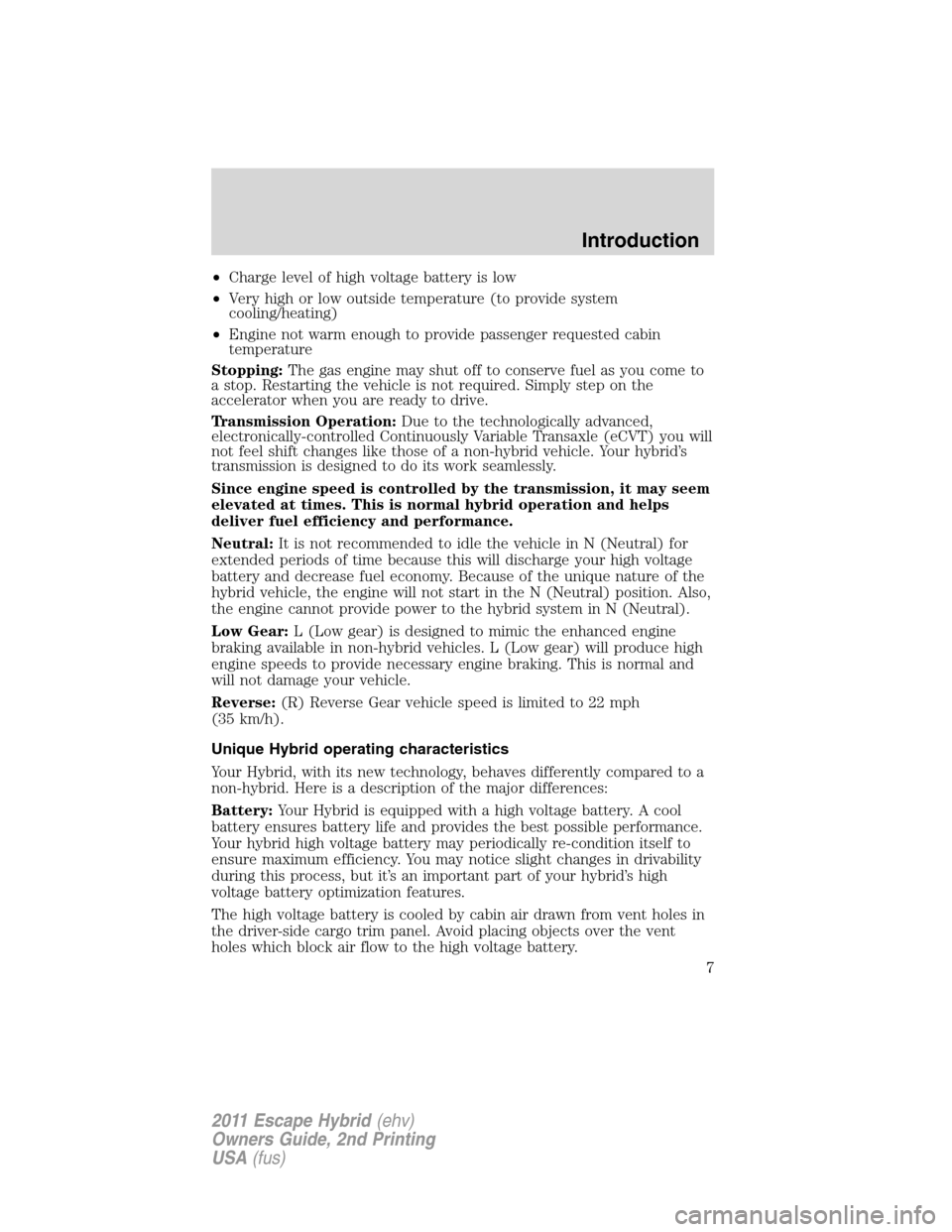
•Charge level of high voltage battery is low
•Very high or low outside temperature (to provide system
cooling/heating)
•Engine not warm enough to provide passenger requested cabin
temperature
Stopping:The gas engine may shut off to conserve fuel as you come to
a stop. Restarting the vehicle is not required. Simply step on the
accelerator when you are ready to drive.
Transmission Operation:Due to the technologically advanced,
electronically-controlled Continuously Variable Transaxle (eCVT) you will
not feel shift changes like those of a non-hybrid vehicle. Your hybrid’s
transmission is designed to do its work seamlessly.
Since engine speed is controlled by the transmission, it may seem
elevated at times. This is normal hybrid operation and helps
deliver fuel efficiency and performance.
Neutral:It is not recommended to idle the vehicle in N (Neutral) for
extended periods of time because this will discharge your high voltage
battery and decrease fuel economy. Because of the unique nature of the
hybrid vehicle, the engine will not start in the N (Neutral) position. Also,
the engine cannot provide power to the hybrid system in N (Neutral).
Low Gear:L (Low gear) is designed to mimic the enhanced engine
braking available in non-hybrid vehicles. L (Low gear) will produce high
engine speeds to provide necessary engine braking. This is normal and
will not damage your vehicle.
Reverse:(R) Reverse Gear vehicle speed is limited to 22 mph
(35 km/h).
Unique Hybrid operating characteristics
Your Hybrid, with its new technology, behaves differently compared to a
non-hybrid. Here is a description of the major differences:
Battery:Your Hybrid is equipped with a high voltage battery. A cool
battery ensures battery life and provides the best possible performance.
Your hybrid high voltage battery may periodically re-condition itself to
ensure maximum efficiency. You may notice slight changes in drivability
during this process, but it’s an important part of your hybrid’s high
voltage battery optimization features.
The high voltage battery is cooled by cabin air drawn from vent holes in
the driver-side cargo trim panel. Avoid placing objects over the vent
holes which block air flow to the high voltage battery.
Introduction
7
2011 Escape Hybrid(ehv)
Owners Guide, 2nd Printing
USA(fus)
Page 8 of 363
![FORD ESCAPE HYBRID 2011 2.G Owners Manual If the vehicle is left inoperative for over 31 days, it may be necessary to
jumpstart the vehicle. For more information, refer toJump starting
(Low voltage [underhood] battery only)in theRoadside Emer FORD ESCAPE HYBRID 2011 2.G Owners Manual If the vehicle is left inoperative for over 31 days, it may be necessary to
jumpstart the vehicle. For more information, refer toJump starting
(Low voltage [underhood] battery only)in theRoadside Emer](/manual-img/11/4886/w960_4886-7.png)
If the vehicle is left inoperative for over 31 days, it may be necessary to
jumpstart the vehicle. For more information, refer toJump starting
(Low voltage [underhood] battery only)in theRoadside Emergencies
chapter and also refer toLow and high voltage battery — storagein
theMaintenance and Specificationschapter.
Engine:The engine speed in your hybrid is not directly tied to your
vehicle speed. Your vehicle’s engine and transmission are designed to
deliver the power you need at the most efficient engine speed. During
heavy accelerations, your hybrid may reach high engine speeds (up to
6000 RPM). This is characteristic of the Atkinson cycle engine
technology helping to maximize your hybrid’s fuel economy.
In prolonged mountainous driving, you may see the engine tachometer
changing without your input. This is intentional and maintains the
battery charge level. You may also notice during extended downhill
driving that your engine continues to run instead of shutting off.
During this “engine braking”, the engine stays on, but it’s not using any
fuel. You may also hear a slight whine or whistle when operating your
vehicle. This is the normal operation of the electric generator in the
hybrid system.
During certain events (such as vehicle servicing) your low voltage
(underhood) battery may become disconnected or disabled. When this
occurs, and after reconnecting the low voltage (underhood) battery and
driving the vehicle, the engine may continue to operate for 3-5 seconds
after the key is turned to the off position. This is a normal condition, as
the vehicle’s computers are relearning the operating characteristics of
your particular engine in order to operate it at maximum efficiency.
Braking:Your hybrid is equipped with standard hydraulic braking and
regenerative braking. Regenerative braking is performed by your
transmission and it captures brake energy and stores it in your high
voltage battery.
Driving to optimize fuel economy
Your fuel economy should improve throughout your hybrid’s break-in
period. As with any vehicle, fuel economy can be significantly impacted
by your driving habits and accessory usage. For best results, keep in
mind these tips:
Tire Inflation:Keep tires properly inflated and only use recommended
size.
Drive Habits:Aggressive driving increases the amount of energy
required to move your vehicle. In general, better fuel economy is
Introduction
8
2011 Escape Hybrid(ehv)
Owners Guide, 2nd Printing
USA(fus)
Page 11 of 363
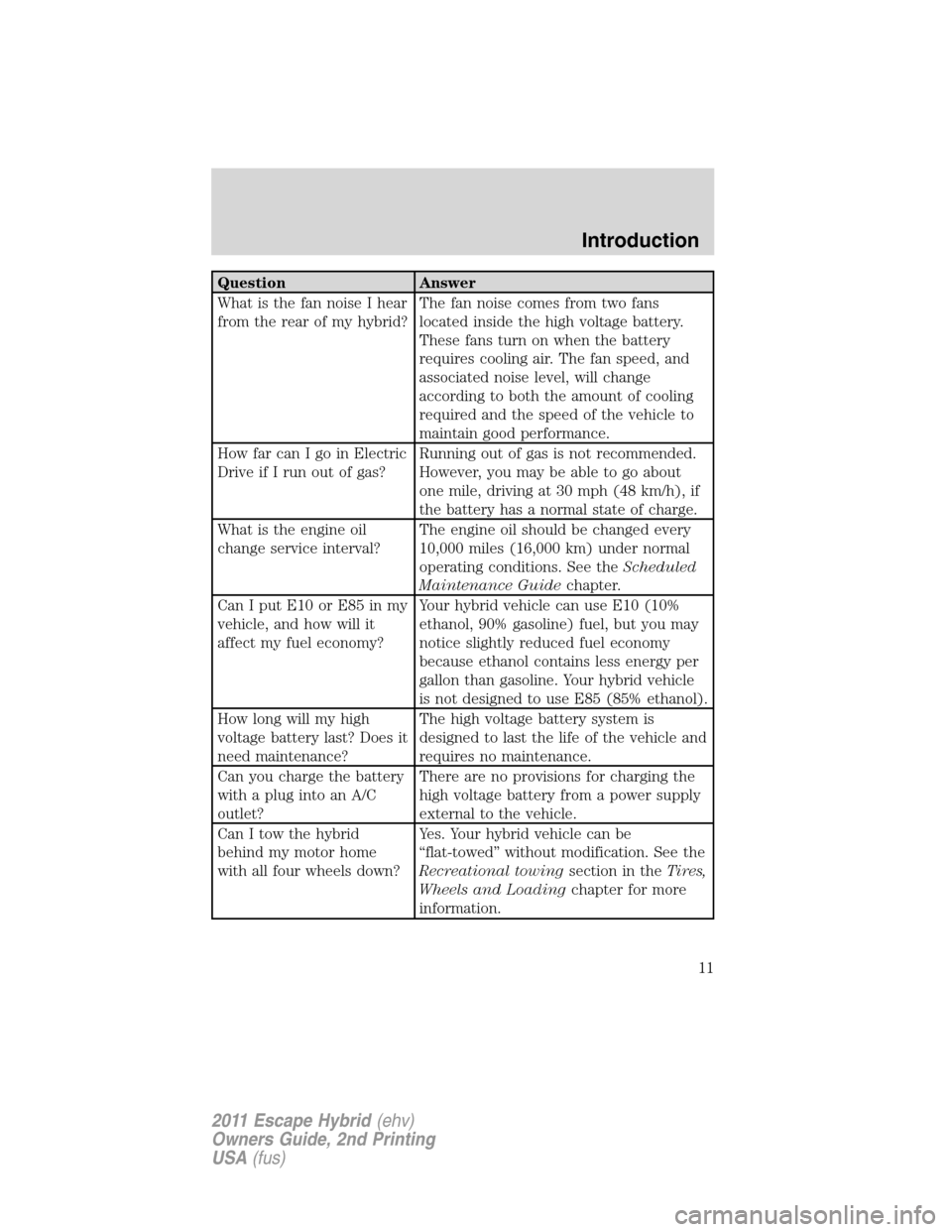
Question Answer
What is the fan noise I hear
from the rear of my hybrid?The fan noise comes from two fans
located inside the high voltage battery.
These fans turn on when the battery
requires cooling air. The fan speed, and
associated noise level, will change
according to both the amount of cooling
required and the speed of the vehicle to
maintain good performance.
How far can I go in Electric
Drive if I run out of gas?Running out of gas is not recommended.
However, you may be able to go about
one mile, driving at 30 mph (48 km/h), if
the battery has a normal state of charge.
What is the engine oil
change service interval?The engine oil should be changed every
10,000 miles (16,000 km) under normal
operating conditions. See theScheduled
Maintenance Guidechapter.
Can I put E10 or E85 in my
vehicle, and how will it
affect my fuel economy?Your hybrid vehicle can use E10 (10%
ethanol, 90% gasoline) fuel, but you may
notice slightly reduced fuel economy
because ethanol contains less energy per
gallon than gasoline. Your hybrid vehicle
is not designed to use E85 (85% ethanol).
How long will my high
voltage battery last? Does it
need maintenance?The high voltage battery system is
designed to last the life of the vehicle and
requires no maintenance.
Can you charge the battery
with a plug into an A/C
outlet?There are no provisions for charging the
high voltage battery from a power supply
external to the vehicle.
Can I tow the hybrid
behind my motor home
with all four wheels down?Yes. Your hybrid vehicle can be
“flat-towed” without modification. See the
Recreational towingsection in theTires,
Wheels and Loadingchapter for more
information.
Introduction
11
2011 Escape Hybrid(ehv)
Owners Guide, 2nd Printing
USA(fus)
Page 27 of 363

System check and vehicle feature customization
Press the SETUP button repeatedly
to cycle the message center through
the following features:
PRESS RESET FOR ENGLISH
When entering the setup menu and a non-English language has been
selected, this message will be displayed to change back to English.
Press the RESET button to change back to English.
RESET FOR SYSTEM CHECK
When this message appears, press the RESET button and the message
center will begin to cycle through the following systems and provide a
status of the item if needed.
1. OIL LIFE
2. ELEC DRIVE
3. BRAKE SYSTEM
4. LIFTGATE AND GLASS
5. DTE/FUEL LEVEL
6. MYKEY DISTANCE (if a MyKey™ is programmed)
7. MYKEY(S) PROGRAMMED
8. ADMIN KEYS PROGRAMMED
9. PARK AID (if equipped)
Note:Some systems show a message only if a condition is present.
OIL LIFE
This displays the remaining oil life.
An oil change is required whenever indicated by the message center and
according to the recommended maintenance schedule. USE ONLY
RECOMMENDED ENGINE OILS.
To reset the oil monitoring system to 100% after each oil change,
perform the following:
1. Press and release the SETUP button to display “OIL LIFE XXX%
HOLD RESET = NEW”.
2. Press and hold the RESET button for two seconds and release to reset
the oil life to 100%.
Instrument Cluster
27
2011 Escape Hybrid(ehv)
Owners Guide, 2nd Printing
USA(fus)
Page 53 of 363
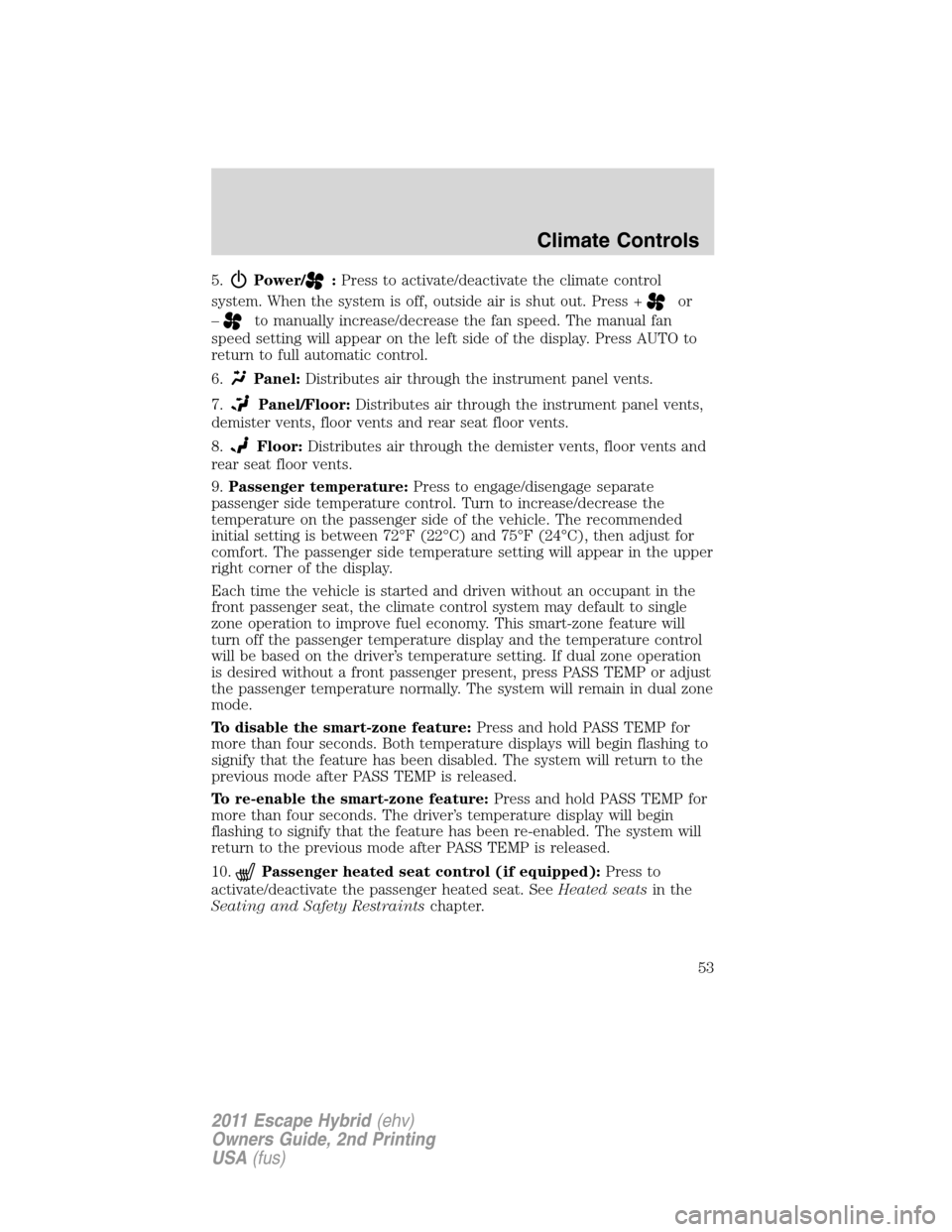
5.Power/:Press to activate/deactivate the climate control
system. When the system is off, outside air is shut out. Press +
or
–
to manually increase/decrease the fan speed. The manual fan
speed setting will appear on the left side of the display. Press AUTO to
return to full automatic control.
6.
Panel:Distributes air through the instrument panel vents.
7.
Panel/Floor:Distributes air through the instrument panel vents,
demister vents, floor vents and rear seat floor vents.
8.
Floor:Distributes air through the demister vents, floor vents and
rear seat floor vents.
9.Passenger temperature:Press to engage/disengage separate
passenger side temperature control. Turn to increase/decrease the
temperature on the passenger side of the vehicle. The recommended
initial setting is between 72°F (22°C) and 75°F (24°C), then adjust for
comfort. The passenger side temperature setting will appear in the upper
right corner of the display.
Each time the vehicle is started and driven without an occupant in the
front passenger seat, the climate control system may default to single
zone operation to improve fuel economy. This smart-zone feature will
turn off the passenger temperature display and the temperature control
will be based on the driver’s temperature setting. If dual zone operation
is desired without a front passenger present, press PASS TEMP or adjust
the passenger temperature normally. The system will remain in dual zone
mode.
To disable the smart-zone feature:Press and hold PASS TEMP for
more than four seconds. Both temperature displays will begin flashing to
signify that the feature has been disabled. The system will return to the
previous mode after PASS TEMP is released.
To re-enable the smart-zone feature:Press and hold PASS TEMP for
more than four seconds. The driver’s temperature display will begin
flashing to signify that the feature has been re-enabled. The system will
return to the previous mode after PASS TEMP is released.
10.
Passenger heated seat control (if equipped):Press to
activate/deactivate the passenger heated seat. SeeHeated seatsin the
Seating and Safety Restraintschapter.
Climate Controls
53
2011 Escape Hybrid(ehv)
Owners Guide, 2nd Printing
USA(fus)
Page 92 of 363
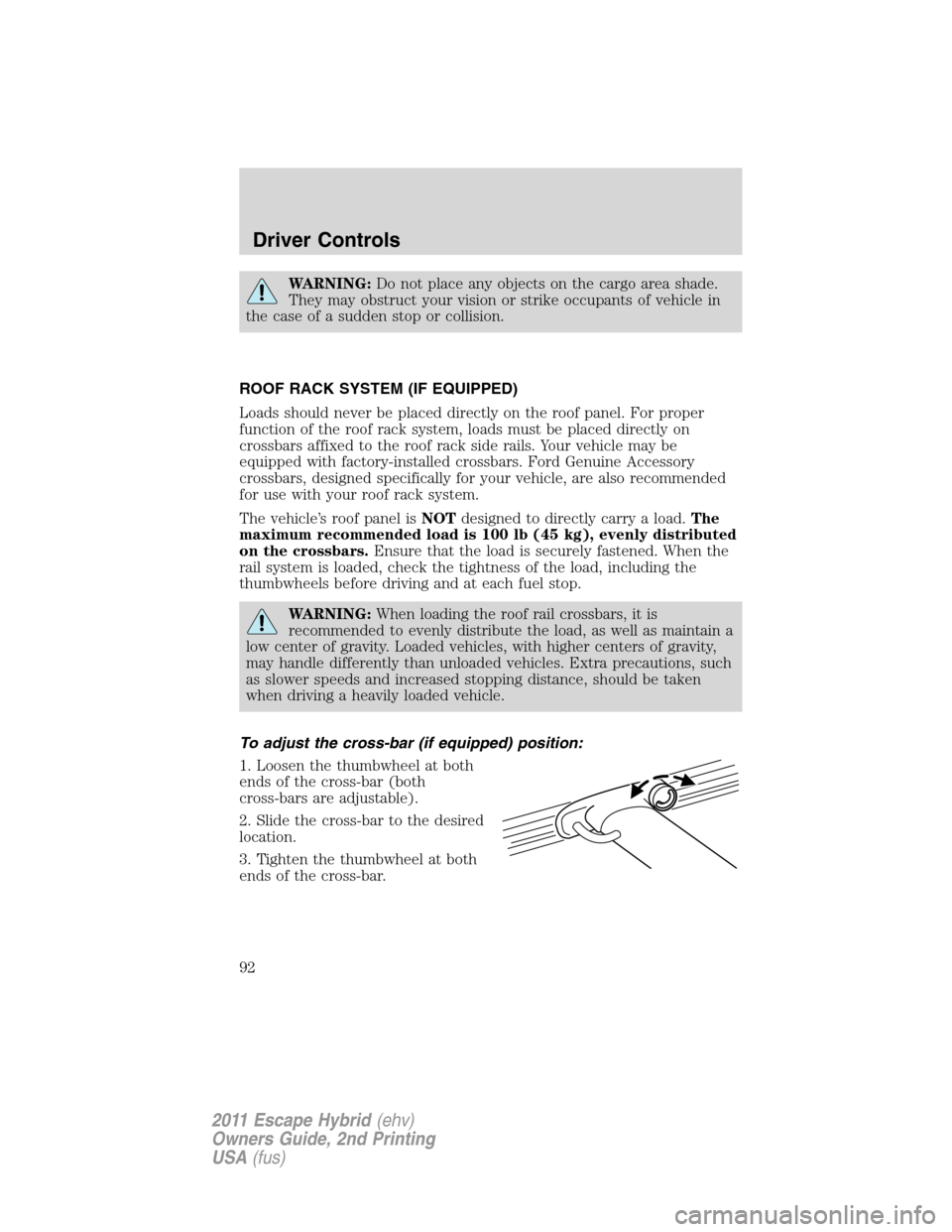
WARNING:Do not place any objects on the cargo area shade.
They may obstruct your vision or strike occupants of vehicle in
the case of a sudden stop or collision.
ROOF RACK SYSTEM (IF EQUIPPED)
Loads should never be placed directly on the roof panel. For proper
function of the roof rack system, loads must be placed directly on
crossbars affixed to the roof rack side rails. Your vehicle may be
equipped with factory-installed crossbars. Ford Genuine Accessory
crossbars, designed specifically for your vehicle, are also recommended
for use with your roof rack system.
The vehicle’s roof panel isNOTdesigned to directly carry a load.The
maximum recommended load is 100 lb (45 kg), evenly distributed
on the crossbars.Ensure that the load is securely fastened. When the
rail system is loaded, check the tightness of the load, including the
thumbwheels before driving and at each fuel stop.
WARNING:When loading the roof rail crossbars, it is
recommended to evenly distribute the load, as well as maintain a
low center of gravity. Loaded vehicles, with higher centers of gravity,
may handle differently than unloaded vehicles. Extra precautions, such
as slower speeds and increased stopping distance, should be taken
when driving a heavily loaded vehicle.
To adjust the cross-bar (if equipped) position:
1. Loosen the thumbwheel at both
ends of the cross-bar (both
cross-bars are adjustable).
2. Slide the cross-bar to the desired
location.
3. Tighten the thumbwheel at both
ends of the cross-bar.
Driver Controls
92
2011 Escape Hybrid(ehv)
Owners Guide, 2nd Printing
USA(fus)
Page 184 of 363

WARNING:When mounting replacement tires and wheels, you
should not exceed the maximum pressure indicated on the
sidewall of the tire to set the beads without additional precautions
listed below. If the beads do not seat at the maximum pressure
indicated, re-lubricate and try again.
When inflating the tire for mounting pressures up to 20 psi (1.38 bar)
greater than the maximum pressure on the tire sidewall, the following
precautions must be taken to protect the person mounting the tire:
1. Make sure that you have the correct tire and wheel size.
2. Lubricate the tire bead and wheel bead seat area again.
3. Stand at a minimum of 12 ft (3.66 m) away from the tire wheel
assembly.
4. Use both eye and ear protection.
For a mounting pressure more than 20 psi (1.38 bar) greater than the
maximum pressure, a Ford dealer or other tire service professional
should do the mounting.
Always inflate steel carcass tires with a remote air fill with the person
inflating standing at a minimum of 12 ft (3.66 m) away from the tire
wheel assembly.
Important:Remember to replace the valve stems when the road tires
are replaced on your vehicle.
It is recommended that the two front tires or two rear tires generally be
replaced as a pair.
Note:The use of a different tire can effect the fuel economy of your
vehicle.
The tire pressure monitoring sensors mounted in the wheels (originally
installed on your vehicle) are not designed to be used in aftermarket
wheels.
The use of wheels or tires not recommended by Ford Motor Company
may affect the operation of your tire pressure monitoring system.
If the TPMS indicator is flashing, your TPMS is malfunctioning. Your
replacement tire might be incompatible with your TPMS, or some
component of the TPMS may be damaged.
Tires, Wheels and Loading
184
2011 Escape Hybrid(ehv)
Owners Guide, 2nd Printing
USA(fus)
Page 193 of 363
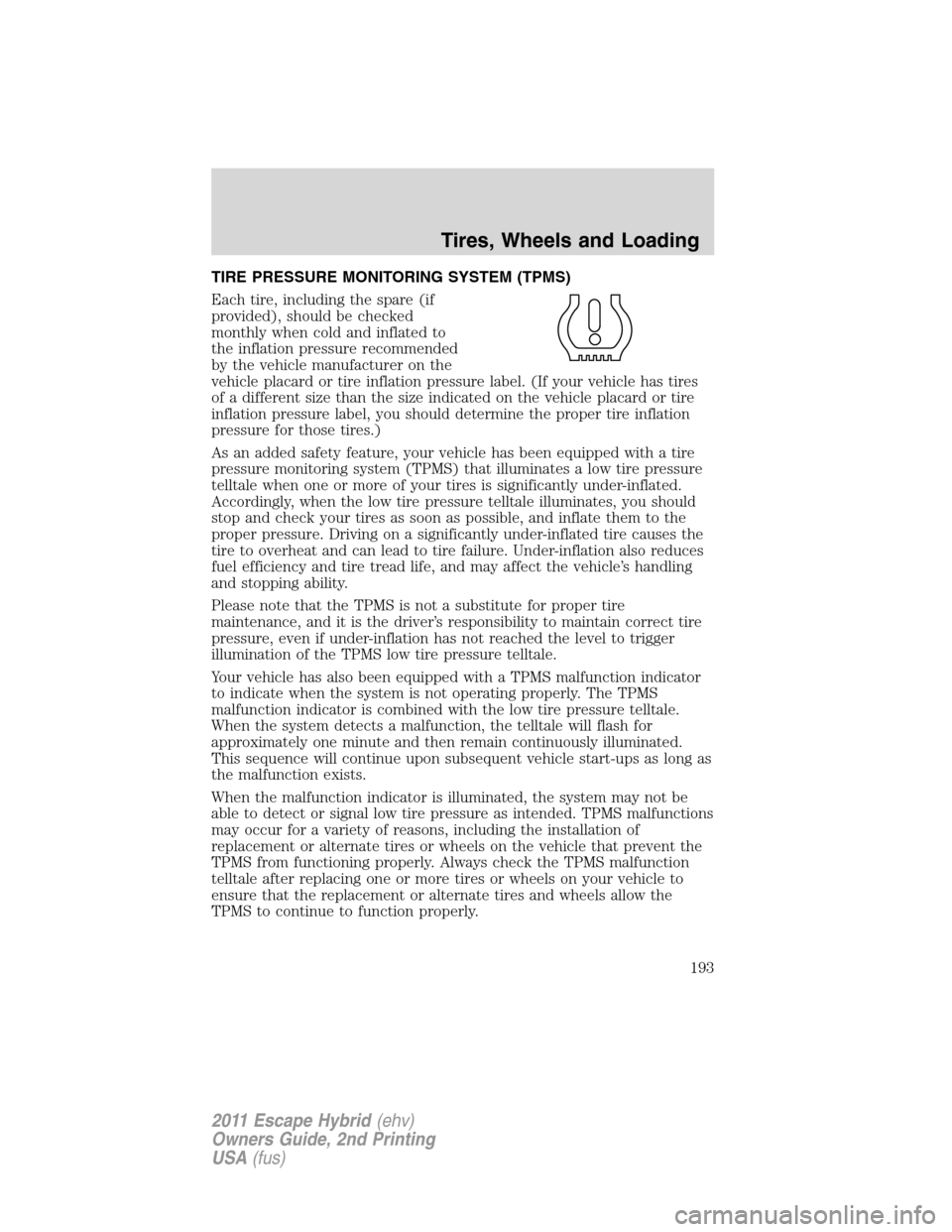
TIRE PRESSURE MONITORING SYSTEM (TPMS)
Each tire, including the spare (if
provided), should be checked
monthly when cold and inflated to
the inflation pressure recommended
by the vehicle manufacturer on the
vehicle placard or tire inflation pressure label. (If your vehicle has tires
of a different size than the size indicated on the vehicle placard or tire
inflation pressure label, you should determine the proper tire inflation
pressure for those tires.)
As an added safety feature, your vehicle has been equipped with a tire
pressure monitoring system (TPMS) that illuminates a low tire pressure
telltale when one or more of your tires is significantly under-inflated.
Accordingly, when the low tire pressure telltale illuminates, you should
stop and check your tires as soon as possible, and inflate them to the
proper pressure. Driving on a significantly under-inflated tire causes the
tire to overheat and can lead to tire failure. Under-inflation also reduces
fuel efficiency and tire tread life, and may affect the vehicle’s handling
and stopping ability.
Please note that the TPMS is not a substitute for proper tire
maintenance, and it is the driver’s responsibility to maintain correct tire
pressure, even if under-inflation has not reached the level to trigger
illumination of the TPMS low tire pressure telltale.
Your vehicle has also been equipped with a TPMS malfunction indicator
to indicate when the system is not operating properly. The TPMS
malfunction indicator is combined with the low tire pressure telltale.
When the system detects a malfunction, the telltale will flash for
approximately one minute and then remain continuously illuminated.
This sequence will continue upon subsequent vehicle start-ups as long as
the malfunction exists.
When the malfunction indicator is illuminated, the system may not be
able to detect or signal low tire pressure as intended. TPMS malfunctions
may occur for a variety of reasons, including the installation of
replacement or alternate tires or wheels on the vehicle that prevent the
TPMS from functioning properly. Always check the TPMS malfunction
telltale after replacing one or more tires or wheels on your vehicle to
ensure that the replacement or alternate tires and wheels allow the
TPMS to continue to function properly.
Tires, Wheels and Loading
193
2011 Escape Hybrid(ehv)
Owners Guide, 2nd Printing
USA(fus)